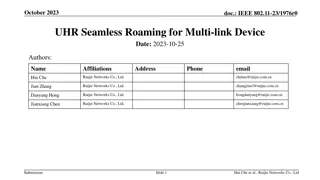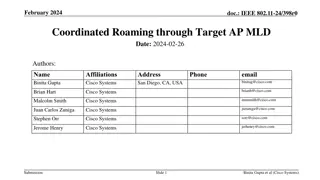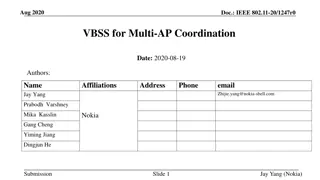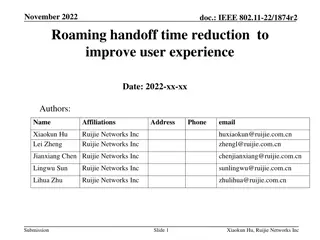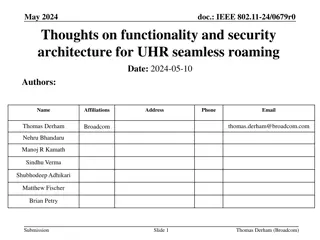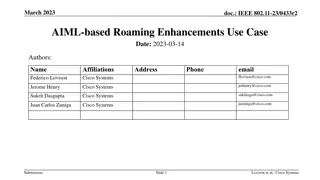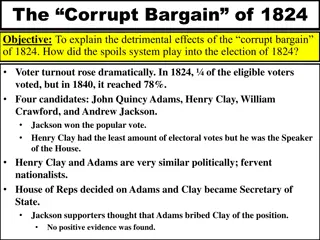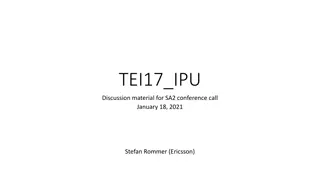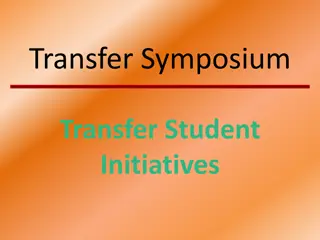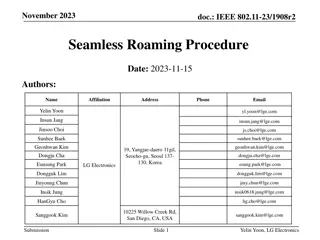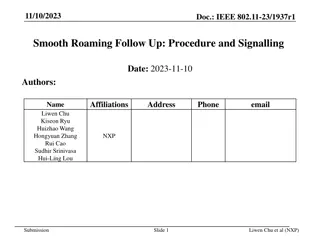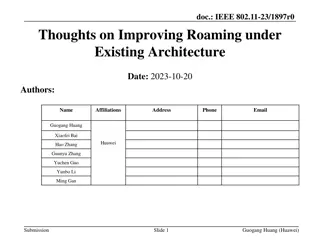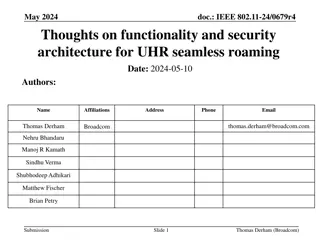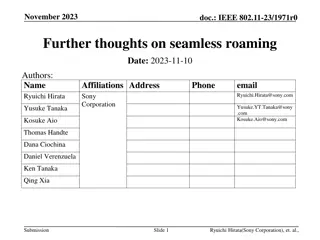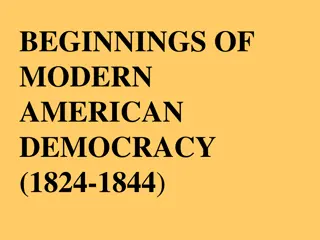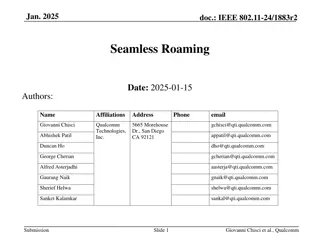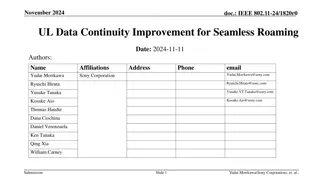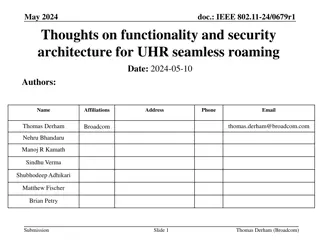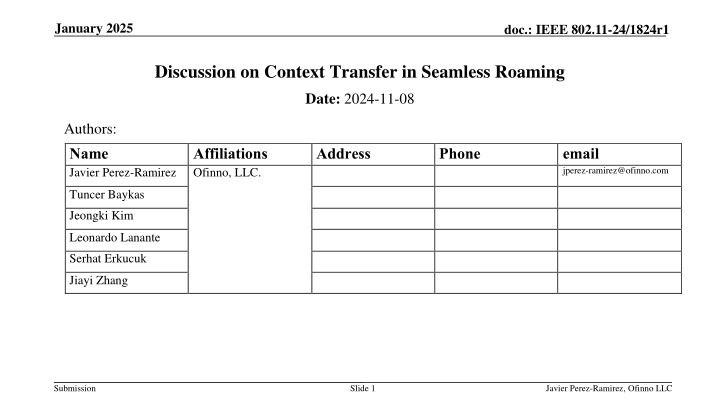
Context Transfer in Seamless Roaming Discussion - IEEE 802.11-24/1824r1
Explore the challenges and solutions related to context transfer during seamless roaming in IEEE 802.11 networks. Understand the complexities of (R)-TWT renegotiation and its impact on Quality of Service during the roaming process. Dive into the implications of establishing new TWT sessions and the potential QoS effects on non-AP MLD communications. Stay informed about the latest developments in enabling seamless/improved roaming in wireless networks.
Download Presentation

Please find below an Image/Link to download the presentation.
The content on the website is provided AS IS for your information and personal use only. It may not be sold, licensed, or shared on other websites without obtaining consent from the author. If you encounter any issues during the download, it is possible that the publisher has removed the file from their server.
You are allowed to download the files provided on this website for personal or commercial use, subject to the condition that they are used lawfully. All files are the property of their respective owners.
The content on the website is provided AS IS for your information and personal use only. It may not be sold, licensed, or shared on other websites without obtaining consent from the author.
E N D
Presentation Transcript
January 2025 doc.: IEEE 802.11-24/1824r1 Discussion on Context Transfer in Seamless Roaming Date: 2024-11-08 Authors: Name Javier Perez-Ramirez Affiliations Ofinno, LLC. Address Phone email jperez-ramirez@ofinno.com Tuncer Baykas Jeongki Kim Leonardo Lanante Serhat Erkucuk Jiayi Zhang Submission Slide 1 Javier Perez-Ramirez, Ofinno LLC
January 2025 doc.: IEEE 802.11-24/1824r1 Abstract Roaming is one of the main topics discussed by the TGbn group. Multiple presentation have focused on how to enable seamless/improved roaming [1-12]. In this presentation we will discuss how to enable (R)-TWT renegotiation in seamless roaming. Submission Slide 2 Javier Perez-Ramirez, Ofinno LLC
January 2025 doc.: IEEE 802.11-24/1824r1 Recap Multiple presentations [1-5] have discussed seamless roaming defining a new controller entity handling the process. Two main phases in the roaming process have been proposed [2-3]: preparation and execution phase. During the preparation phase, the non-AP MLD indicates desire to perform roaming. Static context is transferred to a subset of target AP MLDs to proactively reserve resources. Serving AP MLD responds with an indication of available target MLD APs. Static context may consist of SCS, BA, TWT/r-TWT,.. During execution phase, non-AP MLD indicates target AP MLD to roam to. Dynamic context may consist of SN, PN. Submission Slide 3 Javier Perez-Ramirez, Ofinno LLC
January 2025 doc.: IEEE 802.11-24/1824r1 Transferring current TWT context during roaming may not be possible. Candidate AP MLDs try to reserve resources and respond back to serving AP MLD. In some scenarios, some candidate AP MLDs may respond that only part of the static context can be guaranteed. Transferring current (R)-TWT context may not be possible [6]: There may be potential collisions between solicited implicit TWT schedule and already existing implicit TWT schedule in candidate AP MLD. Submission Slide 4 Javier Perez-Ramirez, Ofinno LLC
January 2025 doc.: IEEE 802.11-24/1824r1 Establishing new TWT session may have negative QoS effects in non-AP MLD communications Non-AP MLD may indicate that it wants to roam to target AP MLD even though current (R)-TWT session won t be roamed. Once non-AP MLD successfully roams to new target AP MLD, it begins a new (R)-TWT negotiation. Depending on channel conditions and (R)-TWT requirements, negotiation can take longer than multiple (R)-TWT Wake intervals. Having a transition period between previous (R)-TWT session and new (R)-TWT session may cause degradation of non-AP MLD QoS. Example: Low latency (LL) traffic might be scheduled using implicit (R)-TWT. In this scenario, long (R)-TWT negotiations may cause such traffic to be delivered late since no (R)-TWT SPs are available during the negotiation. Submission Slide 5 Javier Perez-Ramirez, Ofinno LLC
January 2025 doc.: IEEE 802.11-24/1824r1 (R)-TWT Renegotiation Initiated by Non-AP MLD During Roaming Preparation Phase (1/2) Non-AP MLD notifies through LR Notify it is open for (R)-TWT negotiation. Target AP MLDs respond through LR Notify Response if they accommodate for current (R)- TWT session or not. Additionally, they also can respond with an alternative (R)-TWT schedule. Non-AP MLD responds through LR request either indicating if the accept (R)-TWT suggestion or not with the AP MLD they decide to roam. Submission Slide 6 Javier Perez-Ramirez, Ofinno LLC
November 2024 doc.: IEEE 802.11-24/1824r1 (R)-TWT Renegotiation Initiated by Non-AP MLD During Roaming Preparation Phase (2/2) Non-AP MLD notifies through LR Notify its willingness to roam and to renegotiate the current (R)-TWT schedule using already existing (R)-TWT schedules in target AP. Target APs MLD respond through LR Notify Response if TWT req can be fulfilled. Serving AP MLD receives (R)-TWT schedules (through the DS) suggested by target AP MLD for the non-AP MLD. Serving AP MLD receives (R)-TWT schedules from target AP MLD and shares it with the non-AP MLD through the beacon frame (BF) (broadcast TWT). Non-AP MLD negotiates with target APs MLD (through the serving AP) potentially joining one of their suggested (R)-TWT schedules after roaming completion using TWT req & TWT resp frames. TWT resp. frame indicates acceptance or rejection of TWT req. It also indicates for how long the requested agreement is valid. Non-AP MLD can also request creation of a new (R)-TWT agreement with target AP (through the serving AP) using TWT req & TWT resp frames. Submission Slide 7 Javier Perez-Ramirez, Ofinno LLC
January 2025 doc.: IEEE 802.11-24/1824r1 Conclusions According to [3], seamless roaming is a low/moderate complexity solution to roam clients with low frames lost both in UL and DL. Control plane context (association, security, capabilities) is transferred during roaming. Transferring (R)-TWT context during roaming may not be possible and may have to be renegotiated. We propose (R)-TWT renegotiation during the roaming procedure. Successful (R)-TWT negotiation during roaming may allow non-AP MLD STA to maintain its (R)-TWT session or to join/establish a new one with minimal QoS impact in the associated data streams. Submission Slide 8 Javier Perez-Ramirez, Ofinno LLC
January 2025 doc.: IEEE 802.11-24/1824r1 References [1] 11-24/1595r0 Scope of MAPC and Roaming Standardization (Brian Hart, Cisco Systems) [2] 11-23/2157r2 Seamless Roaming within a Mobility Domain (Binita Gupta, Cisco Systems) [3] 11-24/0396r1 Seamless Roaming within a Mobility Domain Follow Up (Binita Gupta, Cisco Systems) [4] 11-24/398r0 Coordinated Roaming through Target AP MLD (Binita Gupta, Cisco Systems) [5] 11-24/0052r0 Seamless Roaming Details (Duncan Ho, Qualcomm) [6] 11-24/0679r3 Thoughts on Functionality and Security Architecture for UHR Seamless Roaming (Thomas Der ham, Broadcom) [7] 11-23/0322r0 Improve Roaming between MLDs (Po-Kai Huang, Intel) [8] 11-23/1996r0 Improve Roaming between MLDs (Po-Kai Huang, Intel) [9] 11-24/0830r1 Improve Roaming between MLDs follow up (Po-Kai Huang, Intel) [10] 11-24/0881r0 Improving Stability during Roaming Process (Tuncer Baykas, Ofinno LLC) [11] 11-23/1897r0 Thought on Improving Roaming under Existing Architecture (Guogang Huang, Huawei) [12] 11-23/1908r0 Seamless Roaming Procedure (Yelin Yoon, LG Electronics) Submission Slide 9 Javier Perez-Ramirez, Ofinno LLC

